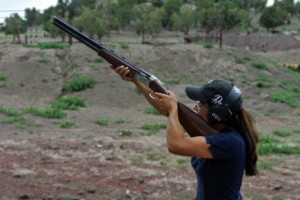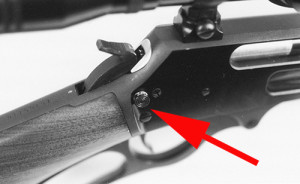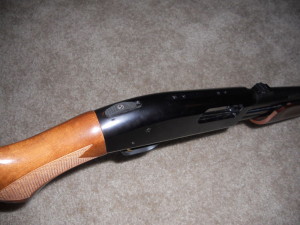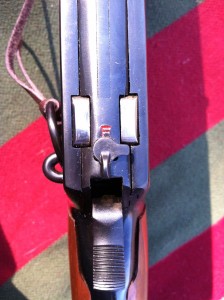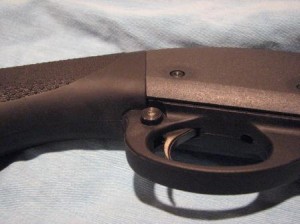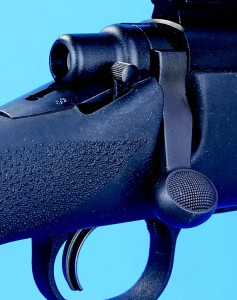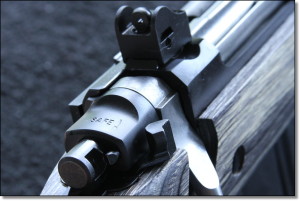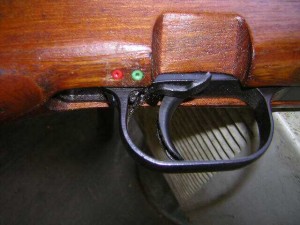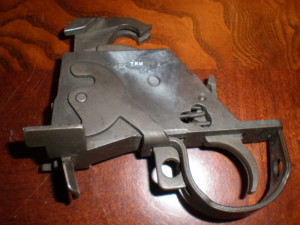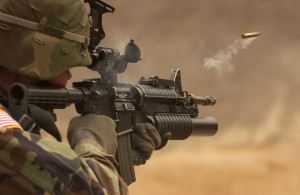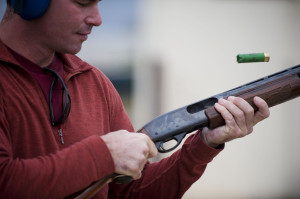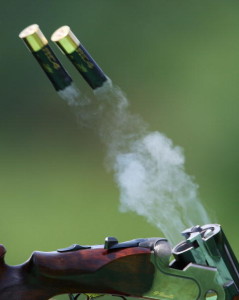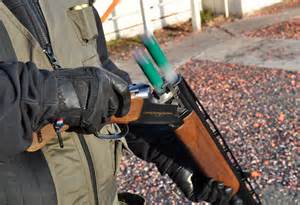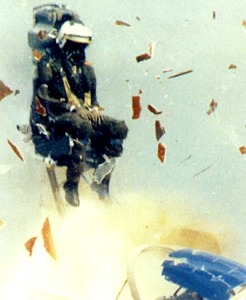The magic happens right before our eyes – or so it seems when shooting a right-handed long gun left-handed.
I am right-handed and right eye dominant. For the majority of life I have handled and shot firearms intended for the right-handed shooter. That changed about ten years ago when an accident forced me rethink my shooting side choices for long guns, especially those in rifle caliber and most especially shotguns. The accident left me with an injury that mitigated my shooting heavy-recoiling long guns right handed. At first, the switch to left-handed shooting was awkward but, being an optimist, I looked on the positive side. I had operated handguns left handed before (and still do to keep the familiarity with doing so alive), but long guns were a different story. To those who already shoot right-handed long guns left-handed, the content of this article will not be new to you. To those right-handers who have considered augmenting your already fine skills with a long gun by shooting left-handed, some information contained in this article might help with the transition and help you become aware of some of the differences that lie in shooting long guns designed for the right-handed shooter from the weak side. I’ll bring to light two topics; safeties and ejection of spent cartridge cases.Safeties:
Top mounted safeties, like those found on the Mossberg shotguns are no problem, as they are usually within reach of the thumb of the shooting hand – regardless of the hand. Remington safeties are located just behind the trigger. For the left-handed operator, the safety will operate just the opposite of what the right-handed operator experiences; left to engage and right to disengage (Fire). A right-handed operator would simply use the thumb of the shooting hand to place the safety in the firing position (push to right). When shooting a right-handed shotgun from the weak side; however, the shooter uses the index finger (the shooting finger) to disengage the safety. At first, this can be confusing, but is quickly learned through practice. Doing it under stress; however, takes a lot of practice since the left-hand has never been taught to operate a safety and the muscle memory is just not there.
The safety on a rifle or carbine can be just about anywhere; top, side, or front. The Rossi series of lever-action rifles have a safety mounted on top of the rifle. For bolt-action hunting rifles, the safety may be on top or on the right rear of the bolt. The M1A incorporates a safety just forward of the trigger and centered in the trigger housing. AR-based rifles normally mount the safety on the left side of the receiver. Marlin lever-action rifles have incorporated a cross-bolt safety behind the trigger since 1984.
Learning to push a cross-bolt safety (like on the Marlin) has been an easy transition for me; simply use the trigger finger to push the safety off. It is actually faster than right-handed operation where the thumb pushes the safety off.
The flip-lever safety on AR-based rifles ; however, I still have not comfortable with. When in the military, I fired the M16 right-handed using the thumb to engage and disengage the safety. My mind is telling my left thumb to do the same thing, but the safety is not there. I am having an ambidextrous safety installed on my AR for safety’s sake (pun not intended) because my thumb keeps wanting to operate it. I find it awkward to use my trigger finger to operate the lever safety.
Handling Extraction and Ejection:
Perhaps the most disconcerting thing for left-handed shooters operating long guns designed for right handed shooters is shell ejection. With bottom-eject long guns, shell ejection is not a problem since the shells are ejected downward. For the majority of long guns, ejection of a spent cartridge is to the right of the firearm (even for top-eject firearms like lever-action rifles modeled after the Winchester). To the right-handed shooter, this means that flying brass and debris is away from the face. When operating a right-handed gun from the left side, ejection of a spent shell is in front of the face. This is especially true with semi-automatic shotguns and rifles that eject hot shells and debris at high rates of speed. Manually operated firearms like lever-action, pump-action, and bolt-action firearms offer an advantage over semi-automatic rifles and shotguns in that the ejection port of the firearm can be manually moved away from the shooter’s face prior to cycling the action. However, and in most cases, the firearm remains shouldered while the operator manually cycles the action and the magic happens right before our eyes – literally.
Which leads us to, in OSHA-speak, “Hazardous Energy Control.”
To prevent the release of hazardous energy the operator must take steps to verify that the energy has been isolated effectively. As firearms operators we isolate the source of energy by manually closing the bolt or allowing the firearm to close the bolt for us automatically. We control the majority of the hazardous energy by the trigger. Once the energy is unleashed, resulting in two stages of recoil, the hazardous energy is either, (1) isolated in a locked breech, or (2) used to unlock the breech automatically.
Let’s talk about the first case; isolation in a locked breech. When all of the hazardous energy is expelled out of the barrel, we can safely remove the expended case from the chamber. Extraction of the expended case is accomplished in two ways; top extraction or side extraction. As the bolt is pushed or pulled rearward, the extractor pulls the expended case from the chamber. At some point in the removal process, an ejector ejected the case from the firearm. The ejector may be part of the bolt or fixed in the receiver. The ejectors job is self-explanatory; eject the expended case from the firearm so that a new cartridge can be loaded (either manually, or automatically). The angle of ejection is important as is the speed in which the expended case is ejected. Weak ejection can cause the expended case to fly more to the rear of the firearm. For the left-handed operator, that means more toward the face rather than away from. For manually operated long guns this means that the operator must operator must move the lever, bolt handle, or pump forearm to the rear with authority and as quickly as possible to ensure proper ejection of the expended case. In performing this operation, it is important to know where one’s face is located in relationship to the path of the bolt and the path of ejection.
- Note #1: Do not use any part of your face to impede the bolt’s rearward movement. There are accommodations for stopping a bolt’s rearward movement in the design of the firearm and it works quite well without your facial assistance.
- Note#2: Keep you head as close to the stock as possible. Do not use any part of your head to impede the expended case’s progress. Case ejection is three-dimensional and in varying degrees; up, back, and right.
- Note #3: Wear protective eye wear – always.
- Note #4: Wear head protection. With a baseball cap (brim forward), the brim is useful in deflecting low, inside ejected cases. Sombreros are not useful in this respect nor are most cowboy hats.
- Note #5: During the expended case’s ejection cycle, slightly tilt the top of the rifle (or shotgun) to the right. This changes the direction of ejection more away the operator.
- Note #6: Keep the face as low on the stock as possible. In most cases, this is adequate to keep your head from interfering with the ejected case’s path.
- Note #7: For double-barreled shotgun operators using an automatic ejection system, dismount the shotgun and tilt the shotgun to the left when unlocking the breech. The expended shells will normally clear the shotgun and you.
- Note #8: When shooting a bolt-action rifle left handed, you will normally use the right hand to operate the bolt (although some use the left-hand, crossover technique). Use you right hand to your advantage to help against being hit with flying brass.
In point #2, where hazardous energy releases the bolt (semi-automatic or fully automatic operation), we really do not have a choice as to when an expended case ejects from the firearm. The force of the bolt moving rearward during semi-automatic or fully automatic operation is many times greater than we, as operators, can muster when moving a bolt rearward manually. The speed and angle of ejection in semi-automatic or fully automatic firearms usually comes down to the speed of which the bolt is moved rearward and how much buffer (gas regulation and/or spring(s)) is used to slow the movement. Moreover, the speed and angle of ejection can vary according to the ammunition used in the firearm.
Note #2 through #6 applies when running semi-automatic and fully automatic firearms when shouldered properly. For those of you who like shooting from the hip – you are on your own.
I would be remiss by not sharing with you the times that I have been hit with hot, ejected cases out of a firearm; some out of my own firearms, some out of others, some from bouncing off a wall in a firing lane at an indoor range. While not many, they have been aggravating. Only one could have resulted in injury had it not been for shooting glasses. With that said, I have to state that I have been hit with more flying brass while shooting semi-automatic pistols than I have with long guns – regardless of which hand is holding them and which is the primary reason for my modified “Weaver” stance when shooting handguns. The second reason is the easy transition from a rifle or shotgun stance to a handgun stance. However, I digress.
Summary:
![]()



